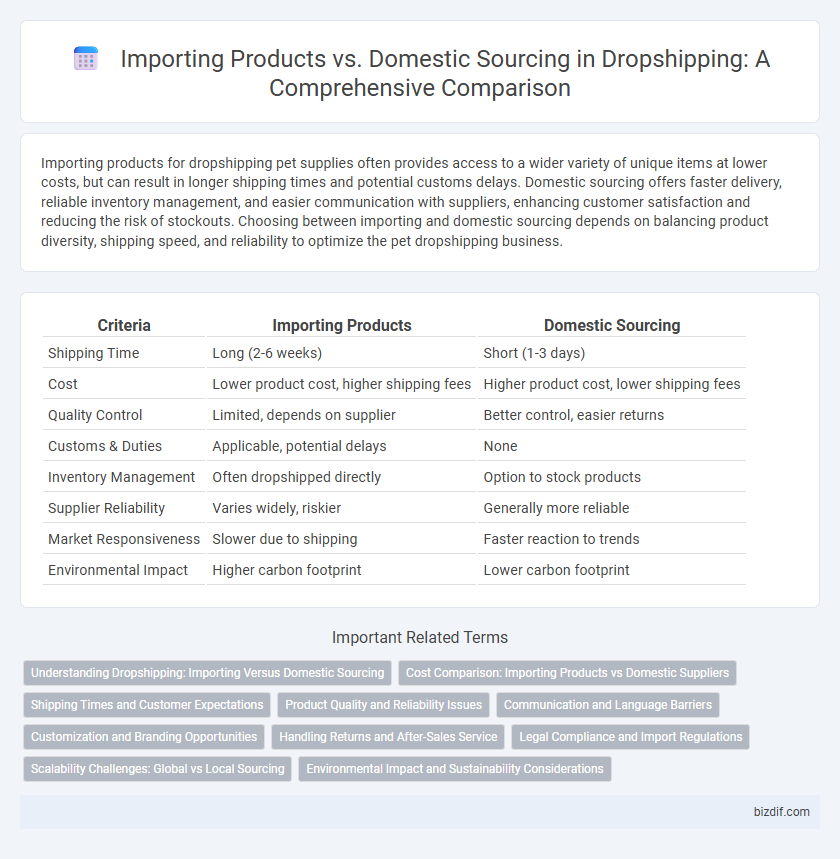Importing products for dropshipping pet supplies often provides access to a wider variety of unique items at lower costs, but can result in longer shipping times and potential customs delays. Domestic sourcing offers faster delivery, reliable inventory management, and easier communication with suppliers, enhancing customer satisfaction and reducing the risk of stockouts. Choosing between importing and domestic sourcing depends on balancing product diversity, shipping speed, and reliability to optimize the pet dropshipping business.
Table of Comparison
| Criteria | Importing Products | Domestic Sourcing |
|---|---|---|
| Shipping Time | Long (2-6 weeks) | Short (1-3 days) |
| Cost | Lower product cost, higher shipping fees | Higher product cost, lower shipping fees |
| Quality Control | Limited, depends on supplier | Better control, easier returns |
| Customs & Duties | Applicable, potential delays | None |
| Inventory Management | Often dropshipped directly | Option to stock products |
| Supplier Reliability | Varies widely, riskier | Generally more reliable |
| Market Responsiveness | Slower due to shipping | Faster reaction to trends |
| Environmental Impact | Higher carbon footprint | Lower carbon footprint |
Understanding Dropshipping: Importing Versus Domestic Sourcing
Importing products for dropshipping often offers access to a wider range of inventory and lower costs, but it may involve longer shipping times and complex customs procedures. Domestic sourcing ensures faster delivery and easier communication, enhancing customer satisfaction and reducing return rates. Evaluating supplier reliability and shipping logistics is crucial for optimizing supply chain efficiency in dropshipping operations.
Cost Comparison: Importing Products vs Domestic Suppliers
Importing products often involves lower unit costs due to cheaper manufacturing in countries like China, but these savings can be offset by shipping fees, tariffs, and longer lead times. Domestic sourcing typically features higher base prices but reduces logistics expenses, customs delays, and enhances inventory control, resulting in faster delivery to customers. Evaluating total landed cost--including product price, shipping, taxes, and handling--is essential to determine the most cost-effective sourcing strategy for dropshipping businesses.
Shipping Times and Customer Expectations
Importing products in dropshipping often results in longer shipping times, which can lead to delayed customer satisfaction and increased order cancellations. Domestic sourcing typically offers faster delivery, enhancing customer experience by meeting the growing demand for quick shipping. Meeting customer expectations through reliable and timely delivery is critical to maintaining positive reviews and reducing return rates.
Product Quality and Reliability Issues
Importing products for dropshipping often involves challenges in maintaining consistent product quality due to longer supply chains and variable manufacturing standards, which can lead to customer dissatisfaction. Domestic sourcing typically ensures higher reliability and faster response times, allowing for better quality control and reduced shipping delays. Prioritizing suppliers with verified quality certifications and robust customer service enhances product reliability regardless of sourcing location.
Communication and Language Barriers
Importing products often involves navigating communication challenges due to language barriers, which can lead to misunderstandings about product specifications, shipping details, and quality control. Domestic sourcing typically allows for clearer and faster communication, enabling quicker resolution of issues and better alignment with customer expectations. Efficient communication reduces delays, enhances supply chain reliability, and improves overall dropshipping business performance.
Customization and Branding Opportunities
Importing products for dropshipping often limits customization options due to supplier constraints and longer production timelines, reducing branding flexibility. Domestic sourcing enables faster turnaround times and greater control over product modifications, enhancing brand differentiation through tailored packaging and exclusive designs. Emphasizing domestic partnerships can improve customer experience by aligning products closely with brand identity and market preferences.
Handling Returns and After-Sales Service
Handling returns and after-sales service in dropshipping varies significantly between importing products and domestic sourcing. Imported products often face longer return processing times and higher shipping costs, complicating customer satisfaction and increasing operational expenses. Domestic sourcing enables faster returns, simplified communication, and improved after-sales service quality, enhancing customer loyalty and reducing overall service costs.
Legal Compliance and Import Regulations
Importing products for dropshipping requires strict adherence to international trade laws, customs duties, and import regulations, including accurate product labeling and compliance with safety standards set by authorities like the U.S. Customs and Border Protection or the EU Customs Union. Domestic sourcing simplifies legal compliance by minimizing tariffs, reducing paperwork for import permits, and ensuring that products meet local regulatory standards such as the FDA for food and health products or the CPSC for consumer goods. Understanding legal obligations and import restrictions is essential to avoid costly fines, shipment delays, and potential seizure of goods.
Scalability Challenges: Global vs Local Sourcing
Importing products in dropshipping often offers a wider range of inventory but presents scalability challenges such as longer shipping times, customs delays, and higher shipping costs that can impact customer satisfaction. Domestic sourcing typically allows for faster delivery, easier quality control, and more reliable supplier communication, which supports smoother scalability and better customer experience. However, local suppliers may have limited product variety and potentially higher prices, requiring careful balancing of cost and operational efficiency for growth.
Environmental Impact and Sustainability Considerations
Importing products for dropshipping often involves long-distance transportation, significantly increasing carbon emissions and contributing to environmental pollution. Domestic sourcing reduces the carbon footprint by minimizing shipping distances and supports local economies, enhancing sustainability efforts. Choosing eco-friendly suppliers and packaging materials further mitigates environmental impact in both importing and domestic sourcing scenarios.
Importing Products vs Domestic Sourcing Infographic

 bizdif.com
bizdif.com